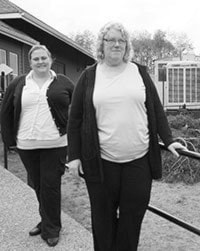Teresa Bird - Black Press
History being passed on to next generation
When Barb Simkins considered retiring as curator of the Kaatza Museum, she knew she would be leaving it in good hands. Intern Megan Dalskog, who has worked and trained with Simkins as a student and volunteer for three years, will take the reigns in November and carry on the work of her mentor.
Simkins started at the museum in 1984, just a year after the museum opened. In 1988 she took advantage of a federal project and was trained as a curator.
In 30 years Simkins has created a lot of exhibits and displays, organized a lot of artifacts, but she has her favourites.
The Pioneer Life display was one of her first and continues to be a favourite both with Simkins and visitors to the museum.
“It was done on pennies and excellent volunteer help,” says Simkins.
It took one and half year to two years planning it and doing it. It was by far the most fun and we won an award for it and recognition from the B.C. Museum Association.”
Simkins says while that display was fun, the one she is most proud of is the IWA display.
“No one had ever done one about the injuries and deaths in the forest industry,” says Simkins. “We built it about five years ago and it was only going to be up for a couple of years but it’s still up and it still touches people. I have lots of satisfaction from that.”
It’s clear Simkins has enjoyed her job.
“Lots of the exhibits were just fun, like the kitchen exhibit and the cabinet of curiosities,” says Simkins. She is partial to an antique wheelchair that is more than 100 years old and to the old typewriter that visitors are welcome to try out. “There are just so many favourites,” laughs Simkins.
For Meghan Dalskog, following in Simkins footsteps is natural. While studying history, photography and anthropology at Vancouver Island University and the University of Victoria, Dalskog got hands-on experience right in her home town at the Kaatza Museum.
“Barb and I work together well,” says Dalzog. “It has worked out well. I was originally interested in the Wilmer Gold photographs, but then I discovered the IWA collection. My grandfather was the IWA international board at one time.” In the collection she found a 90-page interview with her grandfather (who died when Dalskog was two years old) and learned his story, including how he lost his eye and how the Taft Hartley resulted in a lifetime ban on his entering the United States.
She was hooked.
“I have new ideas for fundraising and ideas for various programs for late next year,” says Dalskog. “I have want to do more fun stuff to get kids involved.”
There is always a new research project and new artifacts being donated and exhibits to change or build.
The museum is hoping to receive a grant for cataloguing the IWA collection of that union’s history in B.C. that has been donated to the museum.
“There’s just never enough space,” sighs Salskog. About 60% of the museum’s collection is in storage, the remainder on display. “Some things are important and we keep them just for information. Some things will never go on display, they are too fragile. We are running out of storage space and we hate to turn people away, but sometimes we just can’t store an item safely.”
The museum is fundraising to build an addition to the building that would provide a home for the IWA collection and proper storage and display of the Gold photos and negatives.
Three years ago, when Simkins first considered retiring, she wasn’t sure how to find a replacement, but then Dalskog “fell in our laps”, says Simkins. She plans to continue as a volunteer at the museum and perhaps do some contract work for special projects.
“There is enough work for two people for all the things we want to do,” says Simkins. “Luckily we have a dedicated group of volunteers who do an amazing amount of work.”
